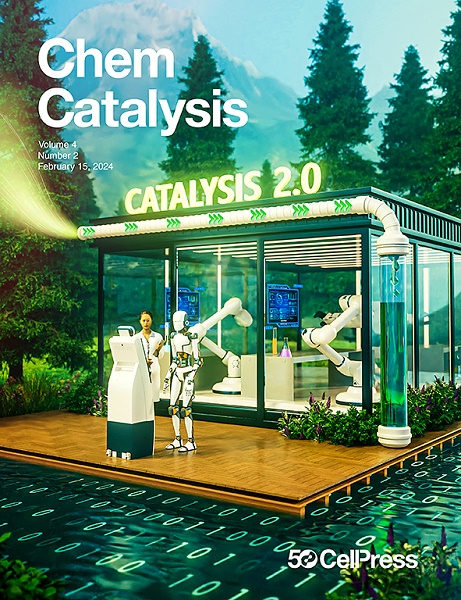Surface electron-donor-boosting single-atom nickel sites for CO2 electroreduction in pure water
IF 11.6
Q1 CHEMISTRY, PHYSICAL
引用次数: 0
Abstract
The electrocatalytic carbon dioxide reduction reaction (CO2RR) in pure water is one of the most promising strategies for avoiding crystallization in conventional electrolytes. Here, we sought to modify the catalyst of dispersed single-atom nickel (Ni) sites on an ultrathin nitrogen-doped carbon nanosheet (Ni–N–C) by using amino groups (Ni–N–C–NH2). The obtained Ni–N–C–NH2 catalysts exhibited a peak turnover frequency of 11.1 s−1 with >90% CO selectivity and ultrastable durability of 100 h of continuous operation and achieved two to three times greater current density than Ni–N–C. Operando spectroscopic evidence combined with theory studies suggested that the improved CO selectivity originates from the synergistic effect of the amino groups and Ni–N–C. The introduced amino groups with the surface property of the electron donor upshift the d-band center of Ni and favor CO2 capture and proton-coupled electron transfer, ultimately enabling highly efficient operation of the CO2RR on Ni–N–C catalysts.

纯水中CO2电还原的表面电子供体增强单原子镍位
纯水中的电催化二氧化碳还原反应(CO2RR)是传统电解质中避免结晶的最有前途的策略之一。在这里,我们试图通过氨基(Ni - n- c - nh2)修饰超薄氮掺杂碳纳米片(Ni - n- c)上分散的单原子镍(Ni)位点的催化剂。Ni-N-C - nh2催化剂的峰值周转频率为11.1 s−1,CO选择性为>;90%,连续运行100 h的超稳定耐久性,电流密度比Ni-N-C高2 ~ 3倍。Operando光谱证据结合理论研究表明,CO选择性的提高源于氨基与Ni-N-C的协同作用。引入的具有电子给体表面性质的氨基使Ni的d带中心上移,有利于CO2捕获和质子耦合电子转移,最终使CO2RR在Ni - n-c催化剂上高效运行。
本文章由计算机程序翻译,如有差异,请以英文原文为准。
求助全文
约1分钟内获得全文
求助全文
来源期刊
CiteScore
10.50
自引率
6.40%
发文量
0
期刊介绍:
Chem Catalysis is a monthly journal that publishes innovative research on fundamental and applied catalysis, providing a platform for researchers across chemistry, chemical engineering, and related fields. It serves as a premier resource for scientists and engineers in academia and industry, covering heterogeneous, homogeneous, and biocatalysis. Emphasizing transformative methods and technologies, the journal aims to advance understanding, introduce novel catalysts, and connect fundamental insights to real-world applications for societal benefit.

 求助内容:
求助内容: 应助结果提醒方式:
应助结果提醒方式:


